Advertisements
Advertisements
प्रश्न
Describe how a potentiometer is used to compare the EMFs of two cells by connecting the cells individually.
उत्तर १
A stable emf E battery is used to create a potential gradient V/L along a potentiometer wire, where V ≡ potential difference across the length L of the wire.
The positive terminals of the cells, whose emf's (E1 and E2) are to be compared, are connected to the high potential terminal A. A two-way key connects the negative terminals of the cells to a galvanometer G. The galvanometer's other end is attached to a pencil jockey. The emf E must be greater than the emfs E1 and E2.

Comparison of two emf's using a potentiometer by the direct method
The cell with emf E1 is brought into the circuit by connecting points P and C.
The jockey is tapped along the wire to find the null point D, which is located at a distance of l1 from A. Then,
E1 = `l_1("V"/"L")`
w, without changing the potential gradient (i.e., without changing the rheostat setting) point Q (instead of P) is connected to C, bringing the cell with emf E2 into the circuit. Let its null point D' be at a distance l2 from A, so that
E2 = `l_2("V"/"L")`
As a result, `"E"_1/"E"_2` can be calculated by measuring the corresponding null lengths l1 and l2. Using the rheostat, the experiment is repeated for different potential gradients.
उत्तर २
- A potentiometer circuit is set up by connecting a battery of emf (E), with a key (K) and a rheostat such that point A is at a higher potential than point B.
- The cells whose EMFs are to be compared are connected with their positive terminals at point A and negative terminals to the extreme terminals of a two-way key K1 and K2.
- The central terminal of the two ways key is connected to a galvanometer. The other end of the galvanometer is connected to a jockey (J).
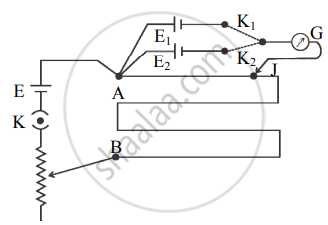
- Key K is closed and then, key K1 is closed and key K2 is kept open. Therefore, the cell of emf E1 comes into the circuit.
- The null point is obtained by touching the jockey at various points on the potentiometer wire AB.
- Let l1 be the length of the wire between the null point and point A.
Here, l1 corresponds to emf E1 of the cell. Therefore,
E1 = K l1 ….(1)
where K is the potential gradient along the potentiometer wire. - Now key K1 is kept open and key K2 is closed. The cell of emf E2 now comes in the circuit. Again, the null point is obtained with the help of the Jockey.
- Let l2 be the length of the wire between the null point and point A.
Here l2 corresponds to the emf E2 of the cell.
∴ E2 = K l2 ….(2) - Dividing equation (1) by equation (2),
`"E"_1/"E"_2 = "l"_1/"l"_2`
Thus, the EMFs of the two cells can be compared and if any one of the EMFs is known, the other can be determined.
संबंधित प्रश्न
A potentiometer wire has resistance of per unit length of 0.1 Ω/m. A cell of e.m.f. 1.5 V balances against a 300 cm length of the wire. Find the current in the potentiometer wire.
SI unit of potential gradient is _______.
(a) V cm
(b) `V/"cm"`
(c) Vm
(d) `V/m`
(i) State the principle on which a potentiometer works. How can a given potentiometer be made more sensitive?

State the underlying principle of a potentiometer ?
State the working principle of a potentiometer. With the help of the circuit diagram, explain how a potentiometer is used to compare the emf's of two primary cells. Obtain the required expression used for comparing the emfs.
In the figure a long uniform potentiometer wire AB is having a constant potential gradient along its length. The null points for the two primary cells of emfs ε1 and ε2 connected in the manner shown are obtained at a distance of 120 cm and 300 cm from the end A. Find (i) ε1/ ε2 and (ii) position of null point for the cell ε1.
How is the sensitivity of a potentiometer increased?
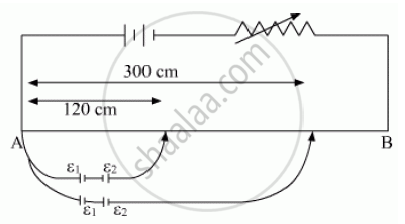
Two students ‘X’ and ‘Y’ perform an experiment on potentiometer separately using the circuit given below:

Keeping other parameters unchanged, how will the position of the null point be affected if
(i) ‘X’ increases the value of resistance R in the set-up by keeping the key K1 closed and the Key K2 opens?
(ii) ‘Y’ decreases the value of resistance S in the set-up, while the key K2 remains open and they K1 closed?
Justify.
The net resistance of an ammeter should be small to ensure that _______________ .
The net resistance of a voltmeter should be large to ensure that ______________ .
Draw a labelled circuit diagram of a potentiometer to compare emfs of two cells. Write the working formula (Derivation not required).
A student uses the circuit diagram of a potentiometer as shown in the figure
(a) for a steady current I passing through the potentiometer wire, he gets a null point for the cell ε1. and not for ε2. Give the reason for this observation and suggest how this difficulty can be resolved.
(b) What is the function of resistance R used in the circuit? How will the change in its value affect the null point?
(c) How can the sensitivity of the potentiometer be increased?
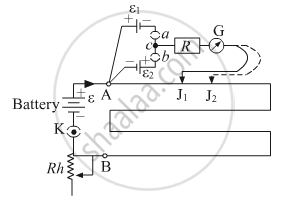
Define or describe a Potentiometer.
State the uses of a potentiometer.
What are the disadvantages of a potentiometer?
Describe with the help of a neat circuit diagram how you will determine the internal resistance of a cell by using a potentiometer. Derive the necessary formula.
A potential drop per unit length along a wire is 5 × 10−3 V/m. If the emf of a cell balances against length 216 cm of this potentiometer wire, find the emf of the cell.
Find the equivalent resistance between the terminals of A and B in the network shown in the figure below given that the resistance of each resistor is 10 ohm.
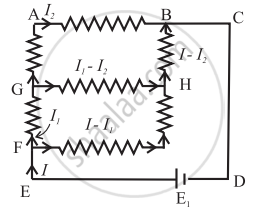
Describe how a potentiometer is used to compare the emf's of two cells by the combination method.
When the null point is obtained in the potentiometer, the current is drawn from the ______
The instrument which can measure terminal potential difference as well as electromotive force (emf) is ______
What is the SI unit of potential gradient?
State any one use of a potentiometer.
A voltmeter has a resistance of 100 Ω. What will be its reading when it is connected across a cell of emf 6 V and internal resistance 20 Ω?
What are the disadvantages of a potentiometer over a voltmeter?
The emf of a standard cell is 1.5V and is balanced by a length of 300 cm of a potentiometer with a 10 m long wire. Find the percentage error in a voltmeter that balances at 350 cm when its reading is 1.8 V.
A potentiometer wire is 4m long and potential difference of 3V is maintained between the ends. The emf of the cell, which balances against a length of 100 cm of the potentiometer wire is ____________.
Two cells having unknown emfs E1 and E2 (E1 > E2) are connected in potentiometer circuit, so as to assist each other. The null point obtained is at 490 cm from the higher potential end. When cell E2 is connected, so as to oppose cell E1, the null point is obtained at 90 cm from the same end. The ratio of the emfs of two cells `("E"_1/"E"_2)` is ______.
The potentiometer is more sensitive, when ______.
A potentiometer is an ideal device for measuring potential difference because ______.
Select the WRONG statement:
The length of a potentiometer wire is L. A cell of e.m.f E is balanced at length L/3 from the positive end of the wire. If the length of wire increases by L/2, then the same cell will give balance point at length ____________.
Sensitivity of a given potentiometer can be decreased by ______.
In the given figure, battery E is balanced on 55 cm length of potentiometer wire but when a resistance of 10 `Omega` is connected in parallel with the battery, then it balances on 50 cm length of the potentiometer wire. The internal resistance r of the battery is ____________.
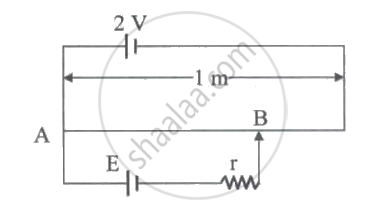
A potentiometer wire of length 100 cm and resistance 3 `Omega` is connected in series with resistance of 8 `Omega` and an accumulator of 4 volt whose internal resistance is 1 `Omega`.
If the length of potentiometer wire is increased, then the length of the previously obtained balance point will ______.
A potentiometer wire of length 'L' and a resistance 'r' are connected in series with a battery of E.M.F. 'E0' and a resistance 'r1'. A cell of unknown E.M.F, 'E' is balanced at a length 'ℓ' of the potentiometer wire. The unknown E.M.F. E is given by ______
Potentiometer measures the potential difference more accurately than a voltmeter, because ______.
In a potentiometer experiment, for measuring internal resistance of a cell, the balance point has been obtained on the fourth wire. The balance point can be shifted to fifth wire by ______.
A potentiometer is an accurate and versatile device to make electrical measurements of E.M.F. because the method involves ______.
A 10 m long wire of uniform cross-section and 20 Ω resistance is used in a potentiometer. The wire is connected in series with a battery of 5 V along with an external resistance of 480 Ω. If an unknown emf E is balanced at 6.0 m length of the wire, then the value of unknown emf is ______.
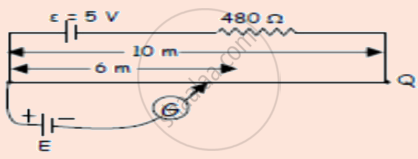
Specific resistance of a conductor increase with.
The instrument among the following which measures the e.m.f of a cell most accurately is ______
In an experiment with a potentiometer, VB = 10V. R is adjusted to be 50Ω (Figure). A student wanting to measure voltage E1 of a battery (approx. 8V) finds no null point possible. He then diminishes R to 10Ω and is able to locate the null point on the last (4th) segment of the potentiometer. Find the resistance of the potentiometer wire and potential drop per unit length across the wire in the second case.
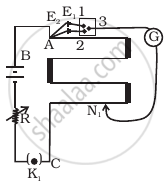
Potential difference between the points A and B in the circuit shown is 16 V, then potential difference across 2Ω resistor is ______ V. volt. (VA > VB)

As a cell age, its internal resistance increases. A voltmeter of resistance 270 Ω connected across an old dry cell reads 1.44 V. However, a potentiometer at the balance point gives a voltage measurement of the cell as 1.5 V. Internal resistance of the cell is ______ Ω.
Two identical thin metal plates has charge q1 and q2 respectively such that q1 > q2. The plates were brought close to each other to form a parallel plate capacitor of capacitance C. The potential difference between them is ______.
A potentiometer wire AB having length L and resistance 12r is joined to a cell D of emf ε and internal resistance r. A cell C having emt `ε/2` and internal resistance 3r is connected. The length AJ at which the galvanometer as shown in the figure shows no deflection is ______.
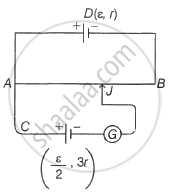
What is the value of resistance for an ideal voltmeter?
The emf of the cell of internal resistance 1.275 Ω balances against a length of 217 cm of a potentiometer wire. Find the balancing length when the cell is shunted by a resistance of 15 Ω.
What will a voltmeter of resistance 200 Ω read when connected across a cell of emf 2 V and internal resistance 2 Ω?
Draw neat labelled diagram of potentiometer as voltage divider.
The Figure below shows a potentiometer circuit in which the driver cell D has an emf of 6 V and internal resistance of 2 Ω. The potentiometer wire AB is 10 m long and has a resistance of 28 Ω. The series resistance RS is of 2 Ω.
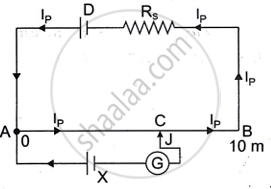
- The current Ip flowing in the potentiometer wire AB when the jockey (J) does not touch the wire AB.
- emf of the cell X if the balancing length AC is 4.5 m.
In a potentiometer, a cell is balanced against 110 cm when the circuit is open. A cell is balanced at 100 cm when short-circuited through a resistance of 10 Ω. Find the internal resistance of the cell.
